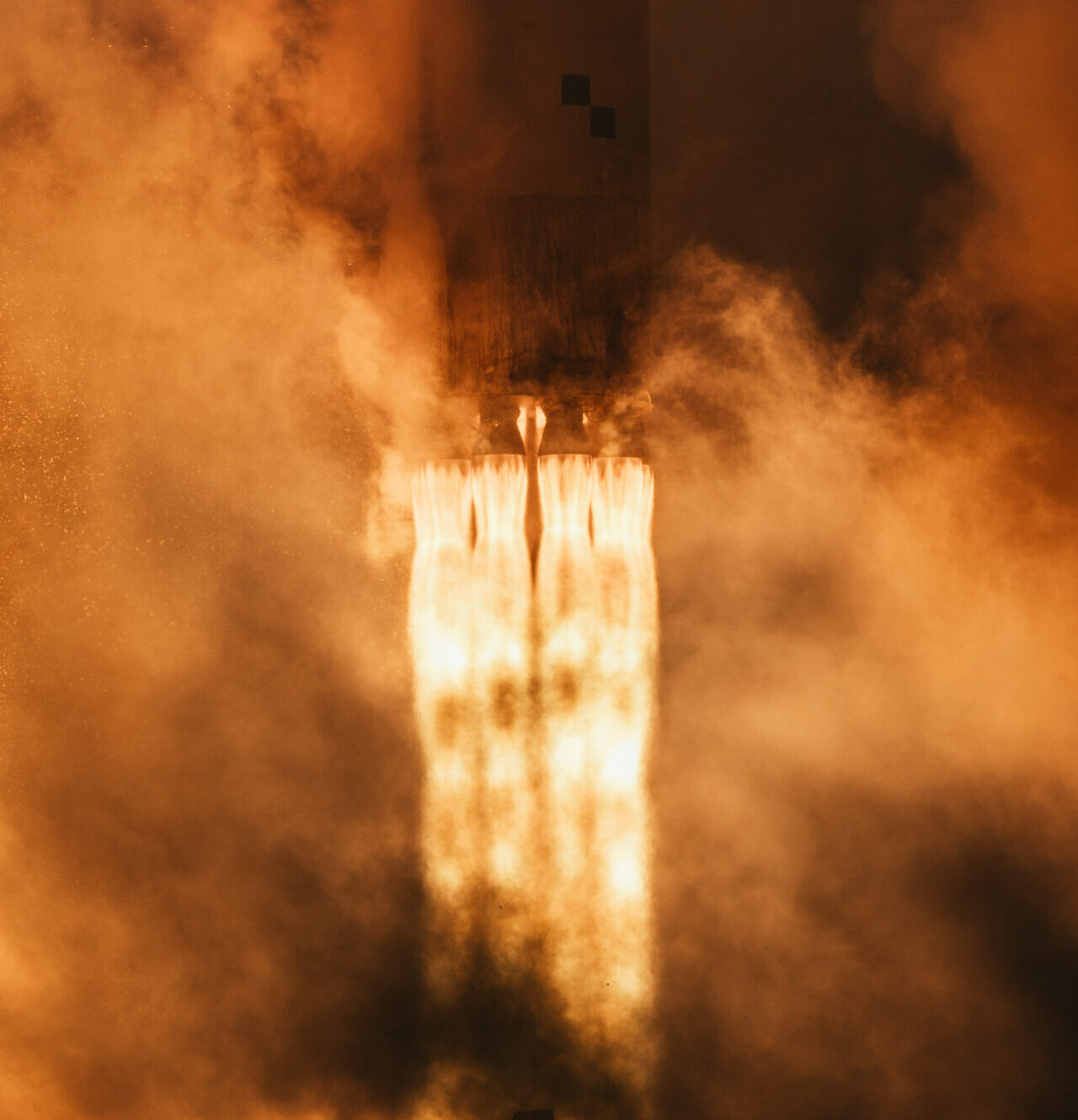PRE-LAUNCH OPERATIONS
Operations began around 5am local time while tracking a 30% weather POV due to a low deck of clouds creating triggered lightning risk. We delayed our T0 slightly to wait for a gap in the weather. During propellant fill, a bulk carrier vessel transiting from Vancouver to Singapore approached the east boundary of our maritime exclusion area, threatening to violate the range. We pulled in our T0, accelerated propellant fill, and successfully cleared our launch commit criteria just before the range went red. We entered a flawless terminal count and ignited the engines.
LIFTOFF + FLIGHT
All nine E2 Sea Level engines ignited and successfully bootstrapped to full thrust. After verifying liftoff criteria, RS1 commanded release of the hold down mechanisms on the GS0 launch stool. Liftoff occurred at 23:27:30 UTC. The quick-disconnect plate separated and the vehicle accelerated off the pad nominally. Tank pressure control and propellant utilization control were both effectively demonstrated in flight conditions. Thrust vector control was nominal, with near zero pitch or yaw control error, and a 2 degree roll immediately zeroed by the controller. RS1 flew in this nominal condition for 10.87 seconds, reaching a max acceleration of 1.23 g’s and altitude of 761 feet.
ANOMALY + IMPACT
At T+10.87 seconds, Stage 1 suffered a complete loss of power. All valves on the stage de-energized. This caused a clean, simultaneous shutdown of all nine engines. Stage 2 continued to operate nominally, transmitting vehicle telemetry to the ground. RS1 ascended for another 2.63 seconds, briefly paused at apogee, and began accelerating downward toward the pad. The vehicle did not tumble, falling vertically for 8.81 seconds before impacting the ground roughly 60 feet east of the launch point. Approximately 95% of the vehicle total propellant mass was still on-board, creating an energetic explosion and overpressure wave that caused damage to nearby equipment and facilities. ABL equipment damaged in the explosion included fuel and water storage tanks, pad communications equipment, and our GS0 launch mount and fluid container. Additionally, fire spread to our nearby fabric hangar, destroying it and much of the integration equipment stored therein. Debris scattered over a 1⁄4 mile radius and was contained within the designated hazard area. In accordance with safety protocol, personnel were clear from the area and not at risk.
RESPONSE + INVESTIGATION
After confirming the pad was in a safe state, ABL and Range personnel approached the pad and initiated our mishap investigation with oversight from the FAA. All vehicle debris is being cataloged and retained. We have formed an anomaly investigation team tasked with identifying root cause of the Stage 1 power loss. As of L+7, we have identified multiple fact patterns of interest. Notably, we saw off-nominal pressure spikes and rises in temperature in the Stage 1 aft cavity a few seconds after liftoff. Additionally, there is some visual evidence of fire or smoke near the vehicle QD and the engine bay after liftoff. Shortly before the power loss, a handful of sensors began dropping out sequentially. This evidence suggests that an unwanted fire spread to our avionics system, causing a system-wide failure. Should the source of the fire be indeterminate, the investigation will identify all undesirable conditions that may have caused, contributed to, or failed to mitigate the fire, as well as opportunities for increased resiliency. Each undesirable condition will be assessed for mitigation on Flight 2, Flight 3 and beyond.
FLIGHT 2
All engines for RS1 SN02 completed acceptance testing in 2022, and both stages are now fully assembled and ready for stage-level testing. GS0 SN02 is largely complete and commissioned. While the investigation continues, the pad will be repaired, after which GS0 and RS1 can deploy ahead of our next launch attempt. Pending the results of our anomaly investigation, we’ll be prepared to share more on the expected timeline for these efforts.
Suffice to say we are ready and motivated to step into Flight 2 with the same focus, efficiency, and speed that has defined the RS1 program to date.
